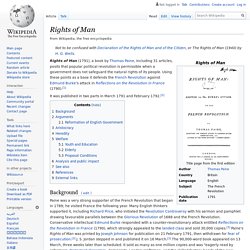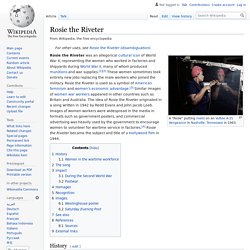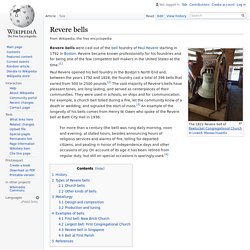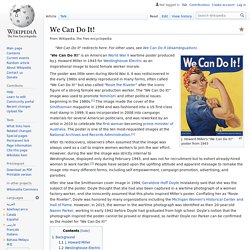

The Rise of American Fascism. Fascism Part II: The Rise of American Fascism by.

Rights of Man - Wikipedia. Rights of Man (1791), a book by Thomas Paine, including 31 articles, posits that popular political revolution is permissible when a government does not safeguard the natural rights of its people.

Using these points as a base it defends the French Revolution against Edmund Burke's attack in Reflections on the Revolution in France (1790).[1] It was published in two parts in March 1791 and February 1792.[2] Background[edit] Arguments[edit] Paine argues that the interests of the monarch and his people are united, and insists that the French Revolution should be understood as one which attacks the despotic principles of the French monarchy, not the king himself, and he takes the Bastille, the main prison in Paris, to symbolise the despotism that had been overthrown.[3] Human rights originate in Nature; thus, rights cannot be granted via political charter, because that implies that rights are legally revocable, hence, would be privileges: ... Rosie the Riveter. Cultural icon of the United States during World War II History[edit] Women in the wartime workforce[edit] Because the world wars were total wars, which required governments to utilize their entire populations to defeat their enemies, millions of women were encouraged to work in the industry and take over jobs previously done by men.

Revere bells. Paul Revere opened his bell foundry in the Boston's North End and, between the years 1792 and 1828, the foundry cast a total of 398 bells that varied from 500 to 2500 pounds.[2] The vast majority of Revere's bells have pleasant tones, are long lasting, and served as centerpieces of their communities.

They were used in schools, on ships and for communication. For example, a church bell tolled during a fire, let the community know of a death or wedding, and signaled the start of mass.[3] An example of the longevity of his bells comes from Henry W. Owen who spoke of the Revere bell at Bath City Hall in 1936: For more than a century (the bell) was rung daily morning, noon and evening, at stated hours, besides announcing hours of religious services and alarms of fire, tolling for departed citizens, and pealing in honor of independence days and other occasions of joy.
On account of its age it has been retired from regular duty, but still on special occasions is sparingly used.[4] History[edit] Black Elk. Heȟáka Sápa (Black Elk) (December 1, 1863 – August 19, 1950)[1] was a famous wičháša wakȟáŋ (medicine man and holy man) and heyoka of the Oglala Lakota (Sioux) who lived in the present-day United States, primarily South Dakota.

He was a second cousin of the war leader Crazy Horse. Near the end of his life, Black Elk met with amateur ethnologist John Neihardt and recounted to him his religious vision, events from his life, and details of Lakota culture. Neihardt edited a translated record and published Black Elk Speaks in 1932. The words of Black Elk have since been published in numerous editions, most recently in 2008. There has been great interest in his work among members of the American Indian Movement since the 1970s and by others who have wanted to learn more about a Native American religion. Black Elk's first wife Katie converted to Roman Catholicism, and they had their three children baptized as Catholics. Childhood[edit] Vision[edit] As Black Elk related: We Can Do It! American wartime propaganda poster J.

Howard Miller's "We Can Do It! " poster from 1943 After its rediscovery, observers often assumed that the image was always used as a call to inspire women workers to join the war effort. However, during the war the image was strictly internal to Westinghouse, displayed only during February 1943, and was not for recruitment but to exhort already-hired women to work harder.[2] People have seized upon the uplifting attitude and apparent message to remake the image into many different forms, including self empowerment, campaign promotion, advertising, and parodies. Smithsonian Admits to Destruction of Thousands of Giant Human Skeletons in Early 1900s. (Humans Are Free) A US Supreme Court ruling has forced the Smithsonian institution to release classified papers dating from the early 1900′s that proves the organization was involved in a major historical cover up of evidence showing giants human remains in the tens of thousands had been uncovered all across America and were ordered to be destroyed by high level administrators to protect the mainstream chronology of human evolution at the time.

The Death of Trujillo: Kennedy Complicity? Home » The Death of Trujillo: Kennedy Complicity?

New Republic;6/28/75, Vol. 172 Issue 26, p7. Attendance rises at Wisconsin historical sites. Lincoln Log Cabin. An accurate replica of the Lincoln cabin was reconstructed on its original site after the State of Illinois acquired the land in 1929.

The cabin reconstruction was based on photographs and affidavits, since the original was lost following its move to the Columbian Exposition in 1892. Both rooms are furnished with items and artifacts of the 1840s, though none are known to have belonged to the Lincolns. Today the Thomas Lincoln Farm comes to life through our historic interpreters.